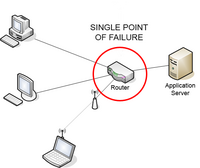
Photo from wikipedia
A subcritical load on a disordered material can induce creep damage. The creep rate in this case exhibits three temporal regimes viz. an initial decelerating regime followed by a steady-state… Click to show full abstract
A subcritical load on a disordered material can induce creep damage. The creep rate in this case exhibits three temporal regimes viz. an initial decelerating regime followed by a steady-state regime and a stage of accelerating creep that ultimately leads to catastrophic breakdown. Due to the statistical regularities in the creep rate, the time evolution of creep rate has often been used to predict residual lifetime until catastrophic breakdown. However, in disordered samples, these efforts met with limited success. Nevertheless, it is clear that as the failure is approached, the damage become increasingly spatially correlated, and the spatio-temporal patterns of acoustic emission, which serve as a proxy for damage accumulation activity, are likely to mirror such correlations. However, due to the high dimensionality of the data and the complex nature of the correlations it is not straightforward to identify the said correlations and thereby the precursory signals of failure. Here we use supervised machine learning to estimate the remaining time to failure of samples of disordered materials. The machine learning algorithm uses as input the temporal signal provided by a mesoscale elastoplastic model for the evolution of creep damage in disordered solids. Machine learning algorithms are well-suited for assessing the proximity to failure from the time series of the acoustic emissions of sheared samples. We show that materials are relatively more predictable for higher disorder while are relatively less predictable for larger system sizes. We find that machine learning predictions, in the vast majority of cases, perform substantially better than other prediction approaches proposed in the literature.
Journal Title: Scientific Reports
Year Published: 2020
Link to full text (if available)
Share on Social Media: Sign Up to like & get
recommendations!